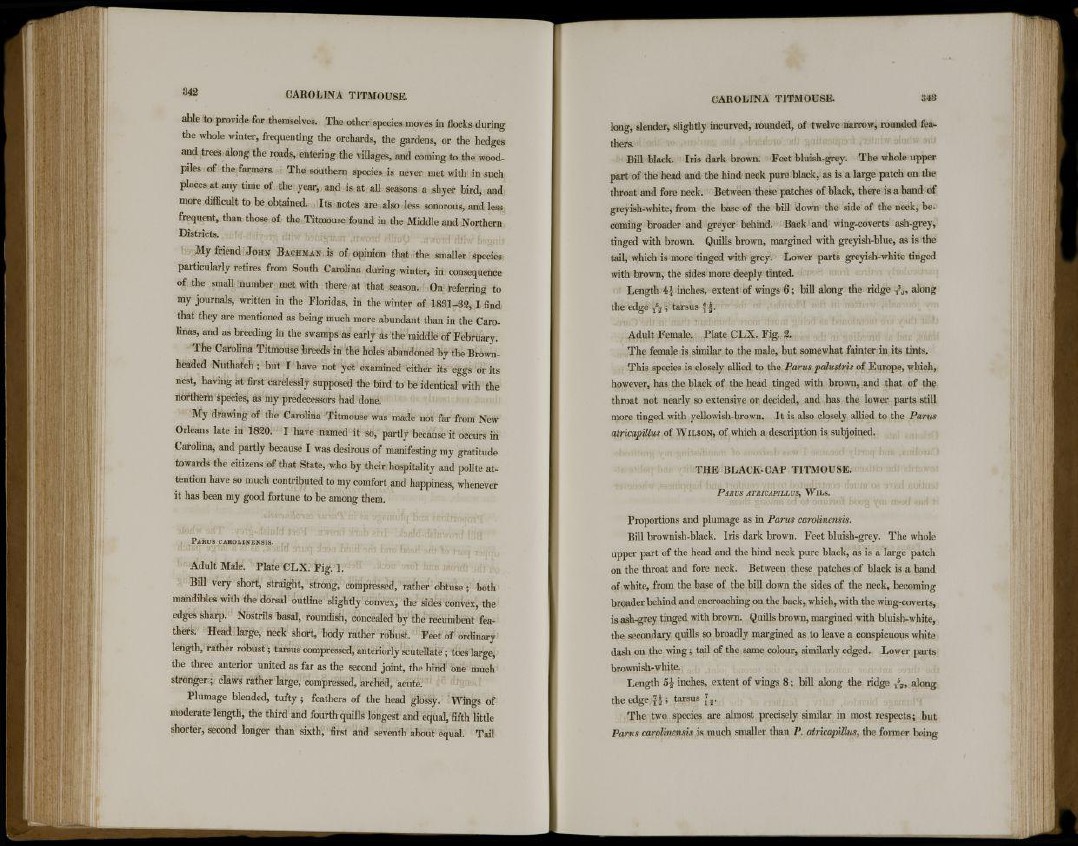
342 CAROLINA TITMOUSE.
able to provide for themselves. The other species moves in flocks during
the whole winter, frequenting the orchards, the gardens, or the hedges
and trees along the roads, entering the villages, and coming to the woodpiles
of the farmers. The southern species is never met with in such
places at any time of the year, and is at all seasons a shyer bird, and
more difficult to be obtained. Its notes are also less sonorous, and less
frequent, than those of the Titmouse found in the Middle and Northern
Districts.
My friend JOHN BACHMAN is of opinion that the smaller species
particularly retires from South Carolina during winter, in consequence
of the small number met with there at that season. On referring to
my journals, written in the Floridas, in the winter of 1831-32, I find
that they are mentioned as being much more abundant than in the Carolinas,
and as breeding in the swamps as early as the middle of February.
The Carolina Titmouse breeds in the holes abandoned by the Brownheaded
Nuthatch ; but I have not yet examined either its eggs or its
nest, having at first carelessly supposed the bird to be identical with the
northern species, as my predecessors had done.
My drawing of the Carolina Titmouse was made not far from New
Orleans late in 1820. I have named it so, partly because it occurs in
Carolina, and partly because I was desirous of manifesting my gratitude
towards the citizens of that State, who by their hospitality and polite attention
have so much contributed to my comfort and happiness, whenever
it has been my good fortune to be among them.
PARUS CAROLINENSIS.
Adult Male. Plate CLX. Fig. 1.
Bill very short, straight, strong, compressed, rather obtuse ; both
mandibles with the dorsal outline slightly convex, the sides convex, the
edges sharp. Nostrils basal, roundish, concealed by the recumbent feathers.
Head large, neck short, body rather robust. Feet of ordinary
length, rather robust; tarsus compressed, anteriorly scutellale ; toes large,
the three anterior united as far as the second joint, the hind one much
stronger ; claws rather large, compressed, arched, acute.
Plumage blended, tufty ; feathers of the head glossy. Wings of
moderate length, the third and fourth quills longest and equal, fifth little
shorter, second longer than sixth, first and seventh about equal. Tail
CAROLINA TITMOUSE. 343
long, slender, slightly incurved, rounded, of twelve narrow, rounded feathers.
Bill black. Iris dark brown. Feet bluish-grey. The whole upper
part of the head and the hind neck pure black, as is a large patch on the
throat and fore neck. Between these patches of black, there is a band of
greyish-white, from the base of the bill down the side of the neck, becoming
broader and greyer behind. Back and wing-coverts ash-grey,
tinged with brown. Quills brown, margined with greyish-blue, as is the
tail, which is more tinged with grey. Lower parts greyish-white tinged
with brown, the sides more deeply tinted.
Length 4 | inches, extent of wings 6; bill along the ridge T
3
i j , along
the edge ft ; tarsus ° £.
Adult Female. Plate CLX. Fig. 2.
The female is similar to the male, but somewhat fainter in its tints.
This species is closely allied to the Parus palustris of Europe, which,
however, has the black of the head tinged with brown, and that of the
throat not nearly so extensive or decided, and has the lower parts still
more tinged with yellowish-brown. It is also closely allied to the Parus
atricapillus of W I L S O N , of which a description is subjoined.
THE BLACK-CAP TITMOUSE.
PARUS ATRICAPILLUS, WILS.
Proportions and plumage as in Parus carolinensis.
Bill brownish-black. Iris dark brown. Feet bluish-grey. The whole
upper part of the head and the hind neck pure black, as is a large patch
on the throat and fore neck. Between these patches of black is a band
of white, from the base of the bib1 down the sides of the neck, becoming
broader behind and encroaching on the back, which, with the wing-coverts,
is ash-grey tinged with brown. Quills brown, margined with bluish-white,
the secondary quills so broadly margined as to leave a conspicuous white
dash on the wing; tail of the same colour, similarly edged. Lower parts
brownish-white.
Length 5 | inches, extent of wings 8; bill along the ridge ft, along
the edge | | ; tarsus J2 .
The two species are almost precisely similar in most respects; but
Parus carolinensis is much smaller than P. atricapillus, the former being